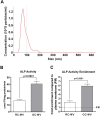MicroRNA Contents in Matrix Vesicles Produced by Growth Plate Chondrocytes are Cell Maturation Dependent
- PMID: 29483516
- PMCID: PMC5826934
- DOI: 10.1038/s41598-018-21517-4
MicroRNA Contents in Matrix Vesicles Produced by Growth Plate Chondrocytes are Cell Maturation Dependent
Abstract
Chondrocytes at different maturation states in the growth plate produce matrix vesicles (MVs), membrane organelles found in the extracellular matrix, with a wide range of contents, such as matrix processing enzymes and receptors for hormones. We have shown that MVs harvested from growth zone (GC) chondrocyte cultures contain abundant small RNAs, including miRNAs. Here, we determined whether RNA also exists in MVs produced by less mature resting zone (RC) chondrocytes and, if so, whether it differs from the RNA in MVs produced by GC cells. Our results showed that RNA, small RNA specifically, was present in RC-MVs, and it was well-protected from RNase by the phospholipid membrane. A group of miRNAs was enriched in RC-MVs compared RC-cells, suggesting that miRNAs are selectively packaged into MVs. High throughput array and RNA sequencing showed that ~39% miRNAs were differentially expressed between RC-MVs and GC-MVs. Individual RT-qPCR also confirmed that miR-122-5p and miR-150-5p were expressed at significantly higher levels in RC-MVs compared to GC-MVs. This study showed that growth plate chondrocytes at different differentiation stages produce different MVs with different miRNA contents, further supporting extracellular vesicle miRNAs play a role as "matrisomes" that mediate the cell-cell communication in cartilage and bone development.
Conflict of interest statement
The authors declare no competing interests.
Figures






Similar articles
-
Specific MicroRNAs Found in Extracellular Matrix Vesicles Regulate Proliferation and Differentiation in Growth Plate Chondrocytes.Calcif Tissue Int. 2021 Oct;109(4):455-468. doi: 10.1007/s00223-021-00855-y. Epub 2021 May 5. Calcif Tissue Int. 2021. PMID: 33950267
-
Selective enrichment of microRNAs in extracellular matrix vesicles produced by growth plate chondrocytes.Bone. 2016 Jul;88:47-55. doi: 10.1016/j.bone.2016.03.018. Epub 2016 Apr 12. Bone. 2016. PMID: 27080510 Free PMC article.
-
Physiological importance of the 1,25(OH)2D3 membrane receptor and evidence for a membrane receptor specific for 24,25(OH)2D3.J Bone Miner Res. 1999 Jun;14(6):856-67. doi: 10.1359/jbmr.1999.14.6.856. J Bone Miner Res. 1999. PMID: 10352093
-
1,25-(OH)2D3 modulates growth plate chondrocytes via membrane receptor-mediated protein kinase C by a mechanism that involves changes in phospholipid metabolism and the action of arachidonic acid and PGE2.Steroids. 1999 Jan-Feb;64(1-2):129-36. doi: 10.1016/s0039-128x(98)00099-3. Steroids. 1999. PMID: 10323681 Review.
-
Regulation of extracellular matrix vesicles via rapid responses to steroid hormones during endochondral bone formation.Steroids. 2019 Feb;142:43-47. doi: 10.1016/j.steroids.2017.12.003. Epub 2017 Dec 9. Steroids. 2019. PMID: 29233620 Review.
Cited by
-
Specific MicroRNAs Found in Extracellular Matrix Vesicles Regulate Proliferation and Differentiation in Growth Plate Chondrocytes.Calcif Tissue Int. 2021 Oct;109(4):455-468. doi: 10.1007/s00223-021-00855-y. Epub 2021 May 5. Calcif Tissue Int. 2021. PMID: 33950267
-
miR-367 as a therapeutic target in stem-like cells from embryonal central nervous system tumors.Mol Oncol. 2019 Dec;13(12):2574-2587. doi: 10.1002/1878-0261.12562. Epub 2019 Aug 22. Mol Oncol. 2019. PMID: 31402560 Free PMC article.
-
Human Bone Marrow Stromal Cell Exosomes Ameliorate Periodontitis.J Dent Res. 2022 Aug;101(9):1110-1118. doi: 10.1177/00220345221084975. Epub 2022 Mar 31. J Dent Res. 2022. PMID: 35356822 Free PMC article.
-
Lineage-specific exosomes could override extracellular matrix mediated human mesenchymal stem cell differentiation.Biomaterials. 2018 Nov;182:312-322. doi: 10.1016/j.biomaterials.2018.08.027. Epub 2018 Aug 11. Biomaterials. 2018. PMID: 30153612 Free PMC article.
-
The Role of Matrix-Bound Extracellular Vesicles in the Regulation of Endochondral Bone Formation.Cells. 2022 May 12;11(10):1619. doi: 10.3390/cells11101619. Cells. 2022. PMID: 35626656 Free PMC article. Review.
References
Publication types
MeSH terms
Substances
Grants and funding
LinkOut - more resources
Full Text Sources
Other Literature Sources
Molecular Biology Databases
Miscellaneous

